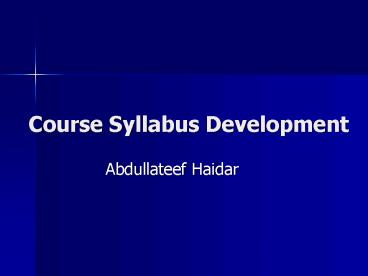Course Syllabus Development - PowerPoint PPT Presentation
1 / 18
Title:
Course Syllabus Development
Description:
Course Syllabus Development Abdullateef Haidar Contents Introduction Some considerations Components of course syllabus Revision matrix Introduction Course syllabus is ... – PowerPoint PPT presentation
Number of Views:78
Avg rating:3.0/5.0
Title: Course Syllabus Development
1
Course Syllabus Development
- Abdullateef Haidar
2
Contents
- Introduction
- Some considerations
- Components of course syllabus
- Revision matrix
3
Introduction
- Course syllabus is your first communication with
your students and it should be as clear and
thorough as possible. - You should discuss it with your students on your
first session. - Students will refer to it throughout the
semester. - Consider carefully what to include and what to
exclude.
4
Some Considerations
- Link course goals to Program Mission and Goals.
- When developing course goals/learning outcomes,
use accreditation terminology as much as
possible. - State course goals/learning outcomes in terms of
performances. - Identify clearly students activities (tasks,
projects, assignments, ).
5
Components Course Syllabus
- Title page
- Table of Contents
- Instructor Information
- Course Purpose/Rationale
- Course Description (catalogue description)
- Course goals and outcomes
- Detailed Course Content (spelled by week)
- Major teaching methods including use of ICT
- Course Requirements
- Evaluation and Grading
- Course Calendar
- Textbook and References
- Not optional
6
1- Title Page
- On your syllabus Title page consider including
the following - Course title/number/section
- Class days and times
- Class location
- Semester and year course is being taught.
- Pre-requisites
7
2- Table of ContentsIt provide an overview for
students of what is important to note about the
course. It may may include
page 1. Instructor Information
page 2. Introduction
page 3. Course Purpose/Rationale
page 4. Course Description
page 5. Course goals and outcomes
page 6. Major teaching methods including use of ICT.
page 7. Detailed course content
page 8. Course Requirements
page 9. Evaluation and Grading
page 10. Course Calendar
page 11. Textbook and references
8
3- Instructor Information
- It may include the following details
- Name
- Office location
- Office phone number
- Home phone number
- Cell phone number
- Office hours
- Short description of research interests,
publications etc.
9
4- Course Purpose/Rationale
- In the Course Purpose section of your syllabus,
consider including the following - Course relevance to program standards (what
standards it helps students to meet). - Importance of the course for their profession.
- More information about the discipline in general
10
5- Course Description
- In the Course Purpose section of your syllabus,
consider including the following - - Major content it covers.
- Major learning outcomes it addresses.
- Emphasis which addresses.
- Major field experiences it will provide
students.
11
6- Course goals and outcomes
- In this section of your syllabus, state clearly
- What are your course goals that are derived from
program goals - What are your course learning outcomes that you
are expecting your students to know and be able
to do after studying this course.
12
7- Detailed Course Content (spelled by week)
- In this section of your syllabus, state clearly
- The major content of the course.
- It is expected that you spell them by week (what
topics you will be covering every week during the
course of the semester).
13
8- Major teaching methods including use of ICT
- In this section of your syllabus, state clearly
- The major teaching methods that you will be
using during the course. - They depend on the nature of the course.
- Active learning teaching methods are
recommended. - Use of ICT should also be stated clearly.
14
9- Course Requirements
- In the Course Requirements section of your
syllabus, consider including the following - Assignments (writing assignments, journals,
portfolios etc.) - Knowledge Tests
- Collaborative work, if applicable
- Individual work
- Community work, if applicable
- Surveys and more.
15
10- Assessment and Grading
- In the Assessment and Grading section of your
syllabus, consider including the following - Attendance
- Class participation
- Late and/or missing assignments
- Academic integrity
- What is Academic dishonesty?
- Academic dishonesty is defined as cheating of any
kind, including misrepresenting one's own work,
taking credit for the work of others without
crediting them and without appropriate
authorization, and the fabrication of information
- Explicit grading criteria
16
11- Course Calendar
- In the Course Calendar section of your syllabus,
consider including the following - Dates of submission all assignments and
- Dates of holding exams
- Dates when readings are due
- Holidays
- Other course-related activities
17
12- Textbook and References
- In this section of your syllabus, include the
following - Name of course textbook(s)
- Handouts
- References that you would like your students to
refer to accomplish course goals and outcomes.
18
Assessment Students' activities Course content Course Goals/learning Outcomes Program Goals
1
2
3
4
5
6
Revision matrix































